The Dos and Don'ts of Meeting Follow-Up

Introduction
Effective meetings are crucial for successful collaboration and decision-making, but the importance of proper follow-up is often overlooked. Meeting follow-up is an essential aspect of ensuring that the outcomes and action items from a meeting are acted upon and that the time and effort invested in the meeting yield tangible results. In this article, we will explore the dos and don'ts of meeting follow-up and provide insights on how to maximize the impact of your meetings.
By following the guidelines outlined in this article, you will be able to:
- Effectively follow up on meeting outcomes
- Avoid common pitfalls that can hinder the success of your meeting follow-up
- Leverage technology to streamline and enhance your follow-up process
- Implement best practices for successful meeting follow-up
Armed with these insights, you will be better equipped to make the most of your meetings and ensure that your team's time is well spent.
The Dos of Meeting Follow-Up
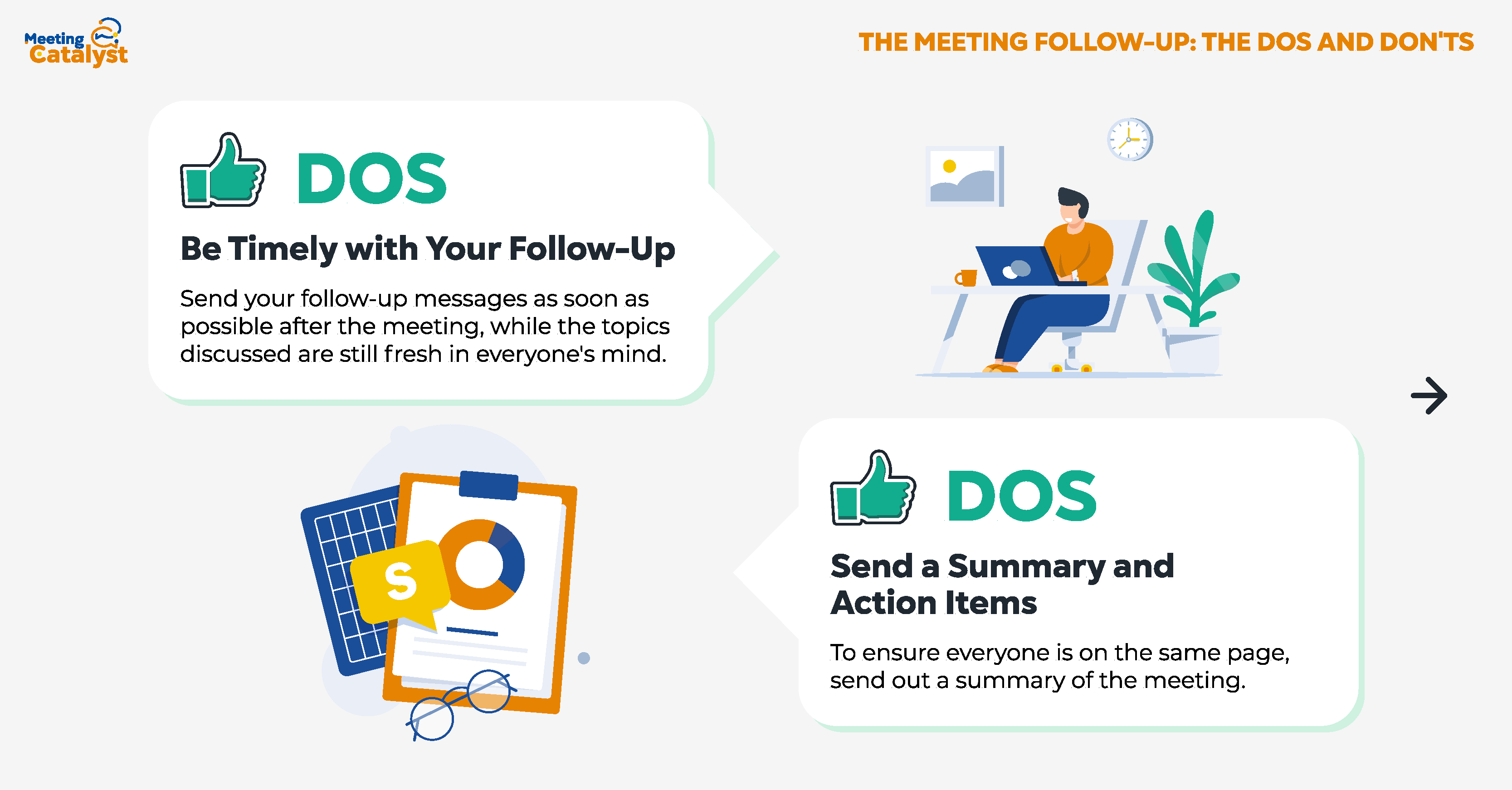
In order to maximize the effectiveness of your meetings, it's crucial to follow up on the outcomes and action items in a timely and efficient manner. Here are some key dos to consider when planning your meeting follow-up:
1. Be Timely with Your Follow-Up
Send your follow-up messages as soon as possible after the meeting, while the topics discussed are still fresh in everyone's mind. This shows your commitment to the meeting outcomes and helps keep momentum going.
2. Send a Summary and Action Items
To ensure everyone is on the same page, send out a summary of the meeting that includes:
- A brief overview of the topics discussed
- The decisions made
- Action items assigned to individuals, along with their deadlines
This will help participants stay organized and accountable for their tasks.
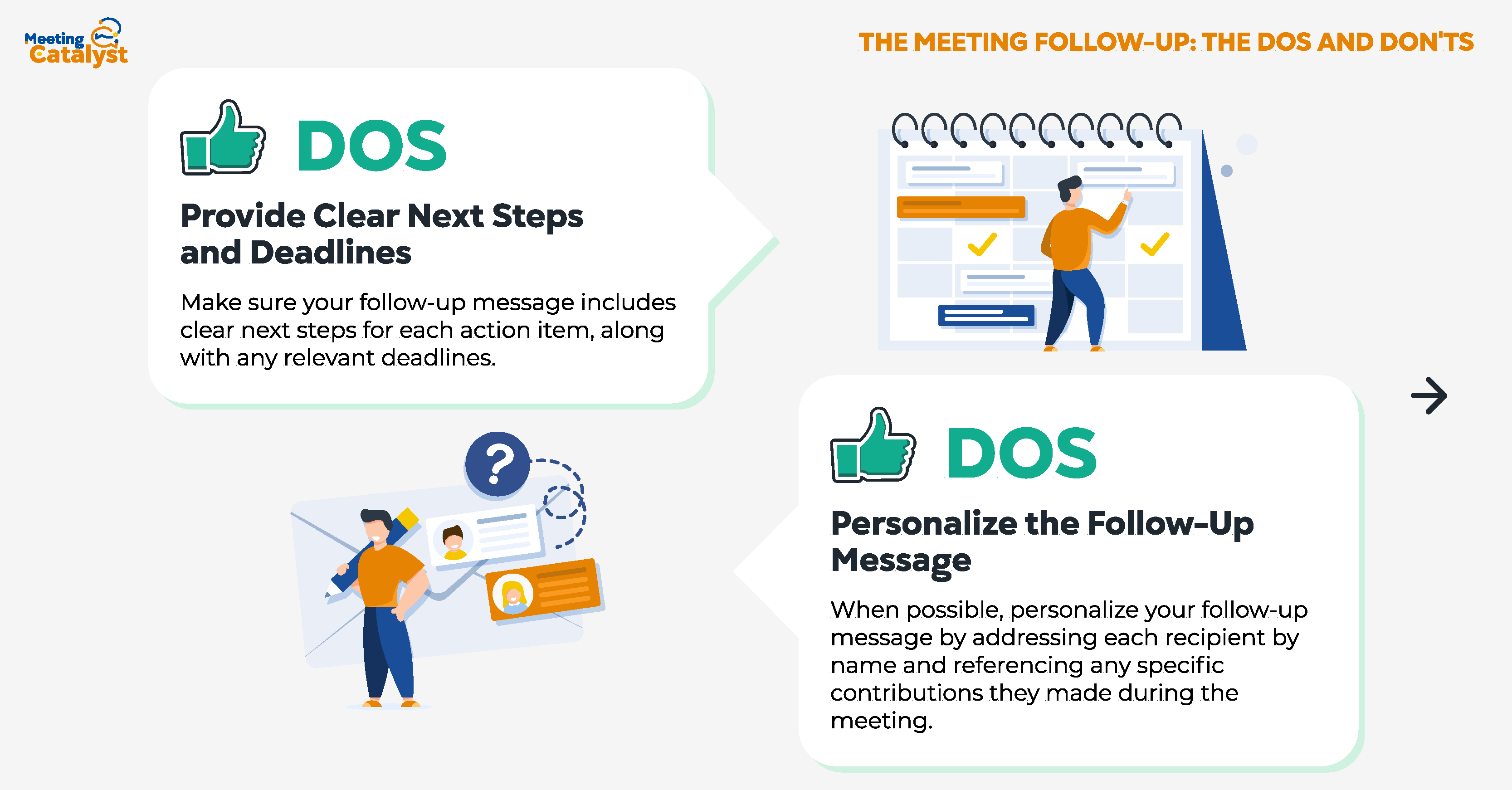
3. Provide Clear Next Steps and Deadlines
Make sure your follow-up message includes clear next steps for each action item, along with any relevant deadlines. This will help your team members understand what is expected of them and when their tasks need to be completed.
4. Personalize the Follow-Up Message
When possible, personalize your follow-up message by addressing each recipient by name and referencing any specific contributions they made during the meeting. This demonstrates that you value their input and helps build rapport within the team.
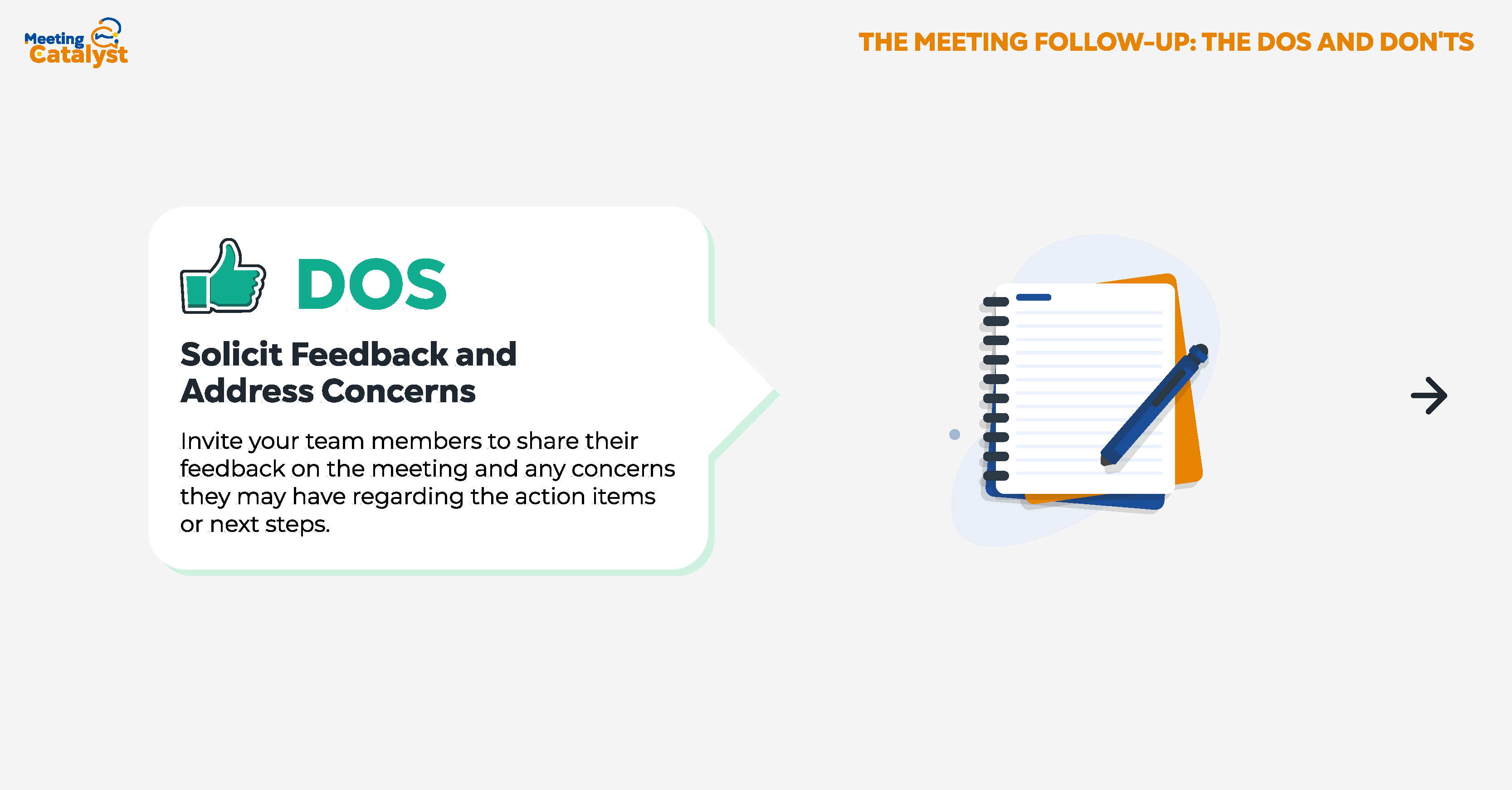
5. Solicit Feedback and Address Concerns
Invite your team members to share their feedback on the meeting and any concerns they may have regarding the action items or next steps. This encourages open communication and allows you to address any potential roadblocks early on.
By following these dos, you will be well on your way to executing effective meeting follow-ups that help your team stay focused, accountable, and engaged in achieving your goals.
The Don'ts of Meeting Follow-Up
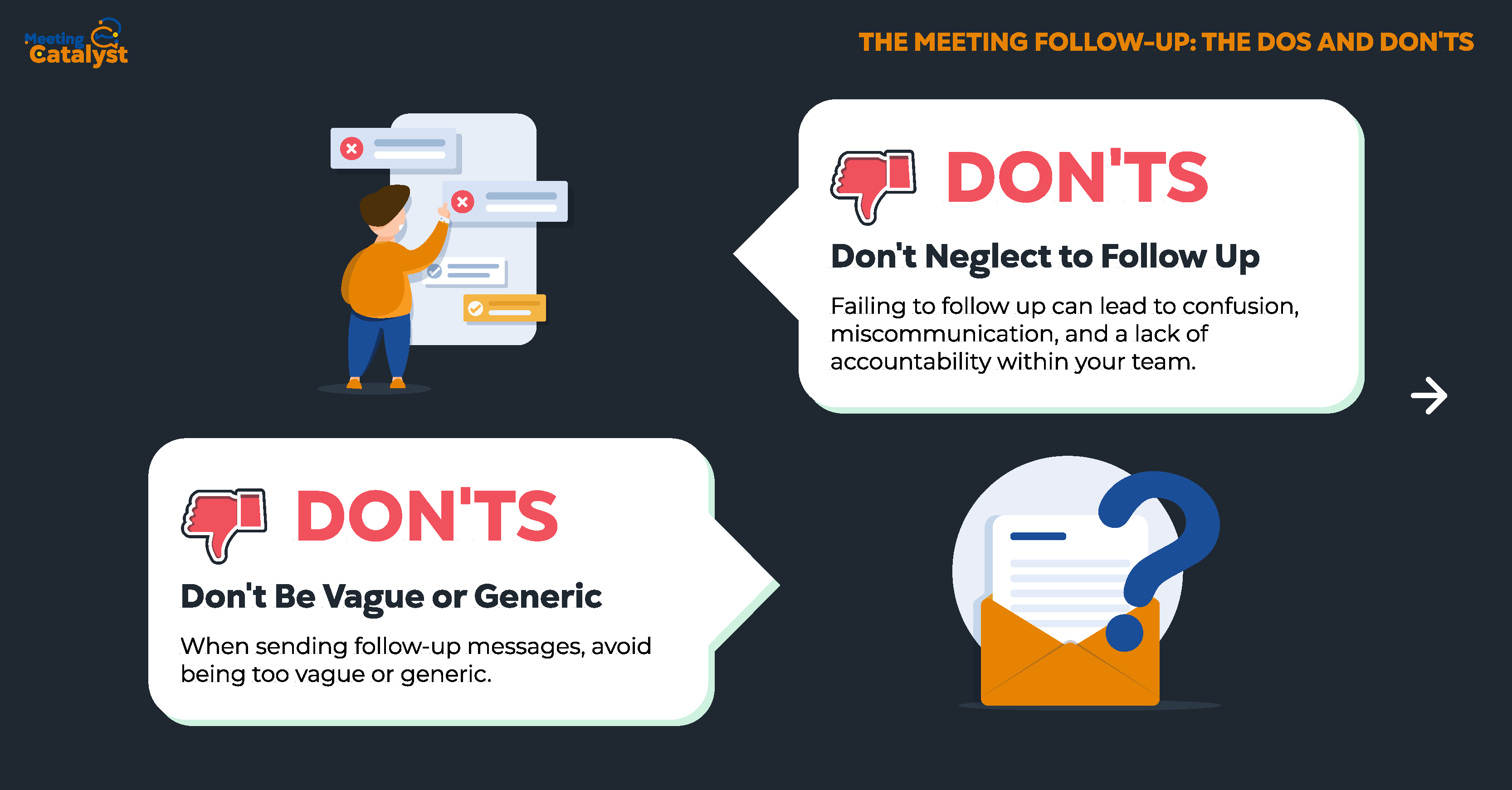
While following up after meetings is essential for success, there are some common pitfalls to avoid. Here are the key don'ts to keep in mind when planning your meeting follow-up:
1. Don't Neglect to Follow Up
One of the biggest mistakes you can make is not following up at all. Failing to follow up can lead to confusion, miscommunication, and a lack of accountability within your team. Always make it a priority to send a follow-up message after every meeting.
2. Don't Be Vague or Generic
When sending follow-up messages, avoid being too vague or generic. Instead, provide specific information about what was discussed, the decisions made, and the action items assigned. This will help ensure everyone is clear on their responsibilities and expectations.
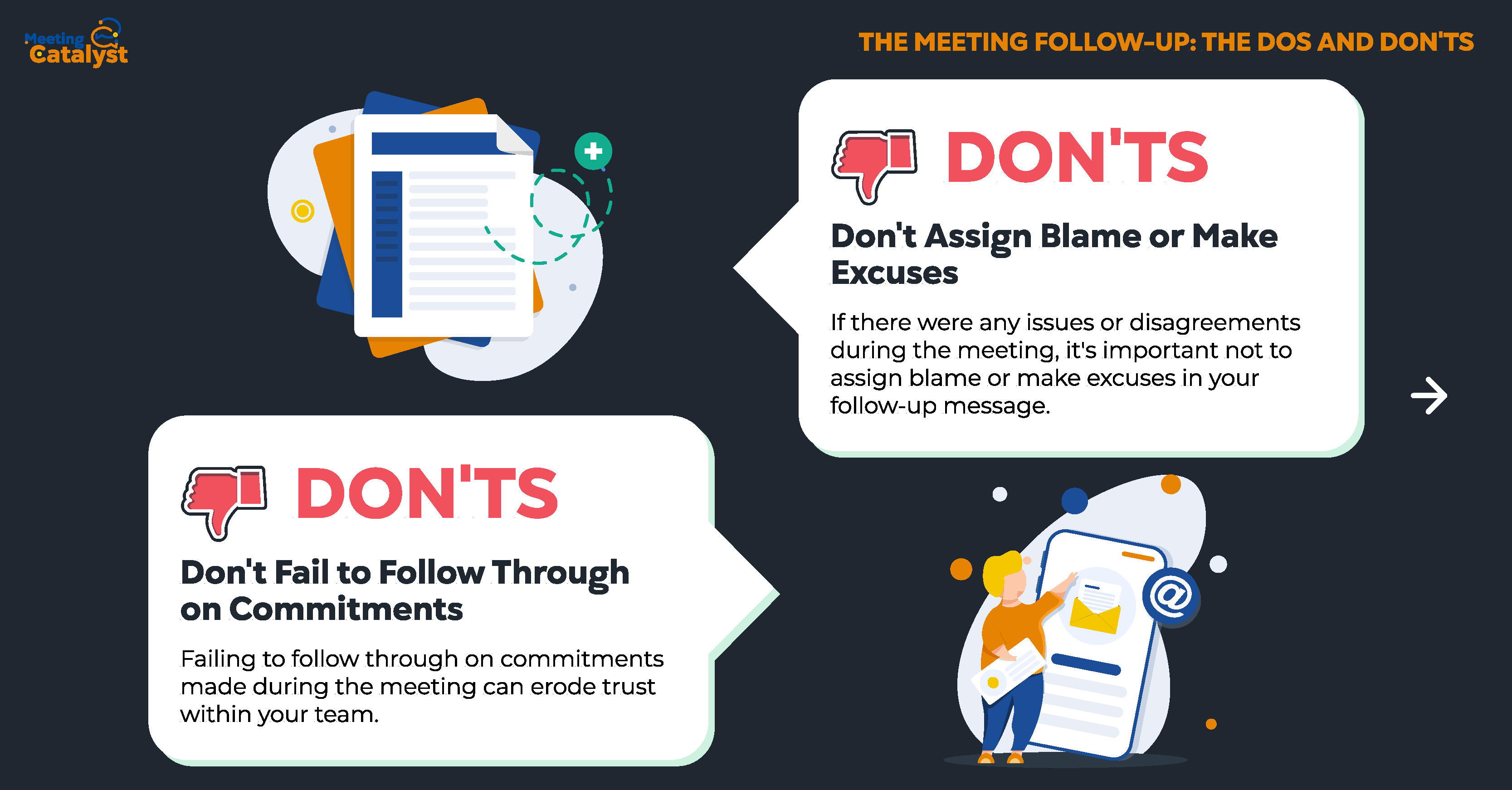
3. Don't Assign Blame or Make Excuses
If there were any issues or disagreements during the meeting, it's important not to assign blame or make excuses in your follow-up message. Instead, focus on finding solutions and moving forward as a team.
4. Don't Fail to Follow Through on Commitments
Failing to follow through on commitments made during the meeting can erode trust within your team. Make sure you and your team members are accountable for completing assigned action items and provide updates on progress as necessary.
By avoiding these common mistakes and adhering to the dos of meeting follow-up, you'll be well on your way to fostering a more productive, engaged, and accountable team environment.
Using Technology for Meeting Follow-Up
In today's fast-paced business world, technology plays a significant role in streamlining and enhancing the meeting follow-up process. By leveraging the right tools and platforms, you can improve the efficiency and effectiveness of your follow-up efforts. Here are some key advantages of using technology for meeting follow-up:
Centralized Communication: Utilizing technology can help you maintain a centralized communication hub for all meeting-related information, making it easier for team members to access and reference relevant documents and action items.
Automated Reminders: Many tools and platforms offer automated reminder features, ensuring that no one misses deadlines or overlooks crucial tasks.
Real-time Collaboration: Cloud-based platforms allow team members to collaborate on tasks and documents in real-time, fostering better communication and coordination throughout the follow-up process.
To make the most of technology in your meeting follow-up, consider using some of the following tools and platforms:
Email Templates: Save time and ensure consistency by creating customized email templates for different types of meetings and follow-up messages. Tools like Gmail or Outlook can help you design and store templates for easy access.
Project Management Software: Platforms like Asana, Trello, and Basecamp facilitate task assignment, progress tracking, and deadline management, making it easier to monitor and manage meeting action items.
CRM Tools: Customer Relationship Management (CRM) tools, such as Salesforce or HubSpot, can be invaluable for sales and client meetings, allowing you to track interactions, schedule follow-up tasks, and maintain up-to-date records of client information.
By embracing technology in your meeting follow-up process, you can streamline communication, enhance collaboration, and ensure that important tasks and deadlines are not overlooked.
Best Practices for Meeting Follow-Up
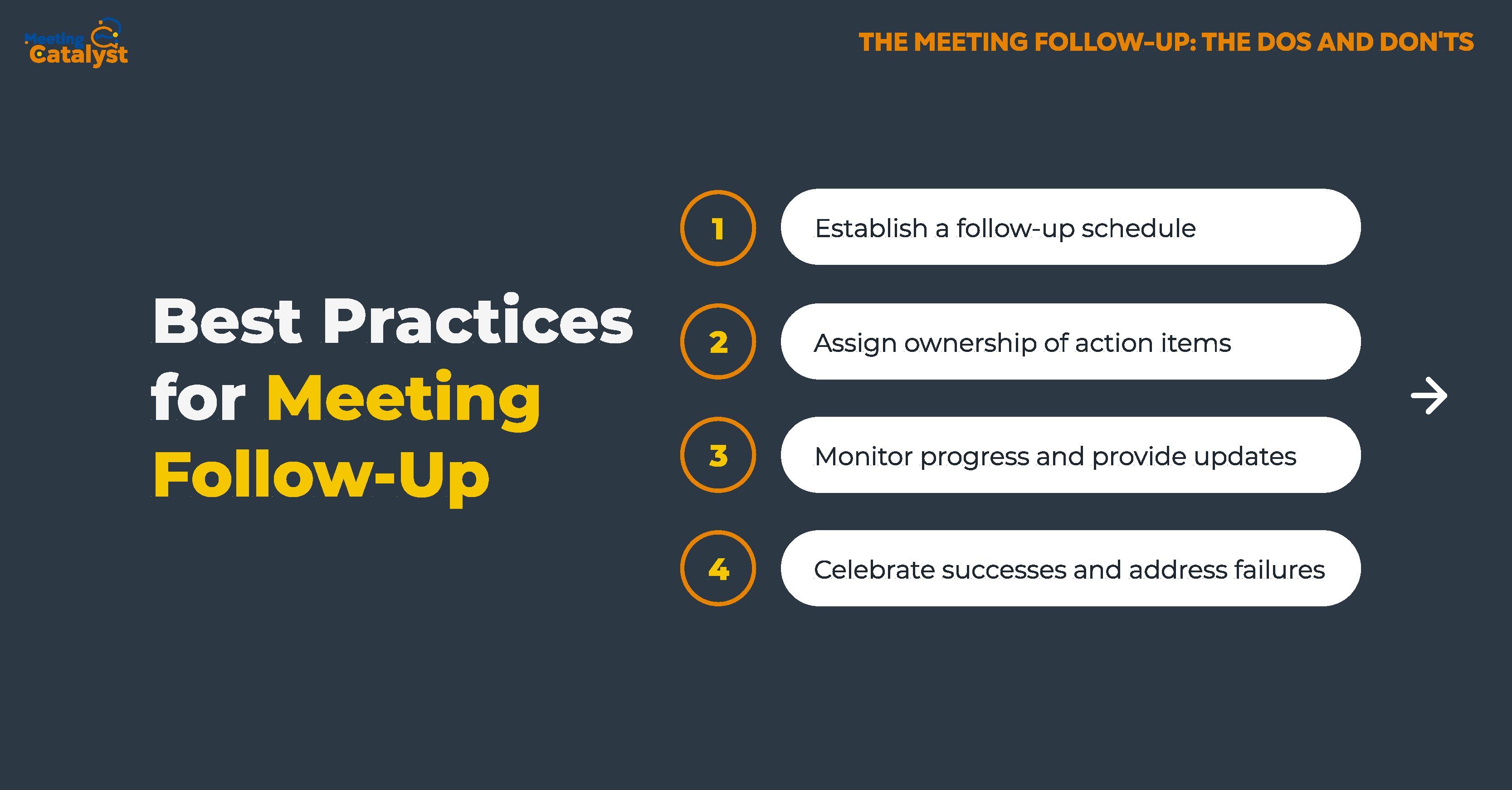
In addition to the dos and don'ts discussed earlier, there are several best practices that can help you optimize your meeting follow-up process. By incorporating these practices into your routine, you can further enhance your team's productivity and ensure that your meetings lead to tangible results.
Establish a follow-up schedule: Determine a regular schedule for following up on meeting action items and deadlines. This could be daily, weekly, or monthly, depending on the nature of your projects and the frequency of your meetings. By having a consistent follow-up schedule, you can keep everyone on track and accountable for their tasks.
Assign ownership of action items: Ensure that each action item is assigned to a specific individual, who is responsible for its completion. This helps avoid confusion, promotes accountability, and ensures that no tasks fall through the cracks.
Monitor progress and provide updates: Regularly review the progress of action items and provide updates to the team. This can be done through status update meetings, email updates, or progress reports within your chosen project management tool. By keeping everyone informed, you can maintain momentum and address any issues or obstacles that arise.
Celebrate successes and address failures: Recognize and celebrate the completion of tasks and milestones to boost team morale and motivation. At the same time, be prepared to address any failures or setbacks constructively, identifying areas for improvement and learning opportunities.
By incorporating these best practices into your meeting follow-up process, you can create a more efficient, accountable, and productive team environment. Remember, successful meeting follow-up is an ongoing process that requires commitment, organization, and open communication. By combining these best practices with the dos and don'ts outlined earlier in this article, you can ensure that your meetings lead to meaningful outcomes and contribute to your team's overall success.
Conclusion
In conclusion, effective meeting follow-up is crucial for turning discussions and decisions into tangible results. By adhering to the dos and avoiding the don'ts, you can optimize your follow-up process and create a more productive and accountable team environment. Moreover, leveraging technology and implementing best practices can further streamline your follow-up process, ensuring that your meetings contribute to your team's overall success.
As a business or team leader, it's essential to recognize the importance of meeting follow-up and actively work towards improving it. By incorporating the strategies and insights discussed in this article, you can take your meetings from good to great, driving productivity and fostering a culture of accountability and open communication. Now is the time to start implementing the dos and avoiding the don'ts of meeting follow-up – your team's success depends on it.
Appendix - Email Template
Subject: Follow-up on [Meeting Topic/Date]
Dear [Attendee Name],
I hope this email finds you well. I wanted to follow up on our recent meeting [or insert specific date, time and location of meeting].
Firstly, I want to thank you for attending and sharing your valuable insights during the meeting. I found our discussion to be productive and informative.
As a follow-up to our meeting, I would like to summarize the key takeaways and action items:
- [Insert key takeaway or action item]
- [Insert key takeaway or action item]
- [Insert key takeaway or action item]
Please let me know if you have any questions or additional feedback. If you would like to discuss any of the items further, please don't hesitate to schedule another meeting with me.
Thank you again for your time and contributions to the meeting.
Best regards, [Your Name]